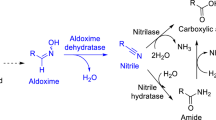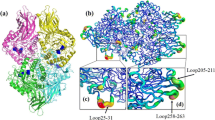Abstract
Under physiological conditions, Bacillus fastidious uricase (BFU) activity shows negligible lagging phase before the exponential decrease; mutants are thus designed for long lagging phases before exponential activity decreases. On homodimer surface of BFU (4R8X.pdb), the last fragment ANSEYVAL at the C-terminus forms a loop whose Y319 is H-bonded by the buried D257 in the same monomer. Within 1.5 nm from the α-carboxyl group of the last leucine (L322), E30, K26, D257, R258, E311, K312 and E318 from the same monomer plus D126 and K127 from a monomer of the other homodimer generate an electrostatic interaction network. Within 1.5 nm from Y319, D307 and R310 in the same monomer interact with ionized residues around the inter-chain β-sheet in the same homodimer. Mutagenesis of Y319R is designed to strengthen the original interactions and concomitantly generate new electrostatic attractions between homodimers. Under physiological conditions, the mutant V144A/Y319R showed an approximately 4 week lagging phase before the exponential activity decrease, an apparent half-life of activity nearly three folds of mutant V144A, but comparable activity. The introduction of ionizable residues into the C-terminus contacting the other homodimer for additional and/or stronger electrostatic attractions between homodimers may be a universal approach to thermostable mutants of uricases.




Similar content being viewed by others
References
García Puig J, Mateos Antón F, López Jiménez M, Conthe Gutiérrez P (1986) Renal handling of uric acid in gout: impaired tubular transport of urate not dependent on serum urate levels. Metabolism 35:1147–1153
So AK, Martinon F (2017) Inflammation in gout: mechanisms and therapeutic targets. Nat Rev Rheumatol 13:639–647
Rock KL, Kataoka H, Lai JJ (2013) Uric acid as a danger signal in gout and its comorbidities. Nat Rev Rheumatol 9:13–23
Stamp LK, Dalbeth N (2019) Prevention and treatment of gout. Nat Rev Rheumatol 15:68–70
Burns CM, Wortmann RL (2011) Gout therapeutics: new drugs for an old disease. Lancet 377:165–177
Garay RP, El-Gewely MR, Labaune JP, Richette P (2012) Therapeutic perspectives on uricases for gout. Joint Bone Spine 79:237–242
Lipsky PE, Calabrese LH, Kavanaugh A, Sundy JS, Wright D, Wolfson M, Becker MA (2014) Pegloticase immunogenicity: the relationship between efficacy and antibody development in patients treated for refractory chronic gout. Arthritis Res Ther 16:R60
Stamp L, Dalbeth N (2014) Screening for hyperuricaemia and gout: a perspective and research agenda. Nat Rev Rheumatol 10:752–756
Zhao Y, Yang X, Lu W, Liao H, Liao F (2009) Uricase based methods for determination of uric acid in serum. Microchim Acta 164:1–6
Huang Y, Chen Y, Yang X, Zhao H, Hu X, Pu J, Liao J, Long G, Liao F (2015) Optimization of pH values to formulate the bireagent kit for serum uric acid assay. Biotechnol Appl Biochem 62:137–144
Liu X, Wen M, Li J, Zhai F, Ruan J, Zhang L, Li S (2011) High-yield expression, purification, characterization, and structure determination of tag-free Candida utilis uricase. Appl Microbiol Biotechnol 92:529–537
Kratzer JT, Lanaspa MA, Murphy MN, Cicerchi C, Graves CL, Tipton PA, Ortlund EA, Johnson RJ, Gaucher EA (2014) Evolutionary history and metabolic insights of ancient mammalian uricases. Proc Natl Acad Sci USA 111:3763–3768
Shi Y, Wang T, Zhou XE, Liu QF, Jiang Y, Xu HE (2019) Structure-based design of a hyperthermostable aguricase for hyperuricemia and gout therapy. Acta Pharmacol Sin 40:1364–1372
Feng J, Wang L, Liu H, Yang X, Liu L, Xie Y, Liu M, Zhao Y, Li X, Wang D, Zhan CG, Liao F (2015) Crystal structure of Bacillus fastidious uricase reveals an unexpected folding of the C-terminus residues crucial for thermostability under physiological conditions. Appl Microbiol Biotechnol 99:7973–7986
Liao F, Feng T, Yang XL, Hu X, Jing Y, Rao J, Liao J (2020) Bacillus fastidius uricase mutants bearing V145A. China Patent 201610093491.8, 10 July 2020
Feng T, Yang X, Wang D, Hu X, Liao J, Pu J, Zhao X, Zhan CG, Liao F (2017) A practical system for high-throughput screening of mutants of Bacillus fastidiosus uricase. Appl Biochem Biotechnol 81:667–681
Nyborg AC, Ward C, Zacco A, Chacko B, Grinberg L, Geoghegan JC, Bean R, Wendeler M, Bartnik F, O’Connor E, Gruia F, Iyer V, Feng H, Roy V, Berge M, Miner JN, Wilson DM, Zhou D, Nicholson S, Wilker C, Wu CY, Wilson S, Jermutus L, Wu H, Owen DA, Osbourn J, Coats S, Baca M (2016) A therapeutic uricase with reduced immunogenicity risk and improved development properties. PLoS ONE 11:e0167935
Bradford MM (1976) A rapid and sensitive method for the quantitation of microgram quantities of protein utilizing the principle of protein-dye binding. Anal Biochem 72:248–254
Feng J, Liu H, Yang X, Gao A, Liao J, Feng L, Pu J, Xie Y, Long G, Li Y, Liao F (2013) Comparison of activity indexes for recognizing enzyme mutants of higher activity with uricase as model. Chem Cent J 7:69
Liao F, Liu WL, Zhou QX, Zeng ZC, Zuo YP (2001) Assay of serum arylesterase activity by fitting to the reaction curve with an integrated rate equation. Clin Chim Acta 314:67–76
Liu M, Yang X, Yuan Y, Tao J, Liao F (2011) PCFenzyme for kinetic analyses of enzyme reaction processes. Proc Environ Sci 8:582–587
Zhao Y, Yang X, Li X, Bu Y, Deng P, Zhang C, Feng J, Xie Y, Zhu S, Yuan H, Yu M, Liao F (2009) Reversible inactivation of an intracellular uricase from Bacillus fastidiosus via dissociation of homotetramer into homodimers in solutions of low ionic strength. Biosci Biotechnol Biochem 73:2141–2144
Wu J, Yang X, Wang D, Hu X, Liao J, Rao J, Pu J, Zhan CG, Liao F (2016) A numerical approach for kinetic analysis of the nonexponential thermoinactivation process of uricase. Protein J 35:318–329
Tian H, Guo Y, Gao X, Yao W (2013) PEGylation enhancement of pH stability of uricase via inhibitive tetramer dissociation. J Pharm Pharmacol 65:53–63
Hibi T, Hayashi Y, Fukada H, Itoh T, Nago T, Nishiya Y (2014) Intersubunit salt bridges with a sulfate anion control subunit dissociation and thermal stabilization of Bacillus sp. TB-90 urate oxidase. Biochemistry 53:3879–3888
Hibi T, Kume A, Kawamura A, Itoh T, Fukada H, Nishiya Y (2016) Hyperstabilization of tetrameric Bacillus sp. TB-90 urate oxidase by introducing disulfide bonds through structural plasticity. Biochemistry 55:724–732
Schein CH (1990) Solubility as a function of protein structure and solvent components. Biotechnology 8:308–317
Shima S, Thauer RK, Ermler U, Durchschlag H, Tziatzios C, Schubert D (2000) A mutation affecting the association equilibrium of formyltransferase from the hyperthermophilic Methanopyrus kandleri and its influence on the enzyme’s activity and thermostability. Eur J Biochem 267:6619–6623
Masetti M, Rocchia W (2014) Molecular mechanics and dynamics: numerical tools to sample the configuration space. Front Biosci 19:578–604
Sheldon JP, Jennifer RC (2010) Protein engineering and design. CRC Press, Boca Raton, p 33487
Feng J, Li X, Yang X, Zhang C, Yuan Y, Pu J, Zhao Y, Xie Y, Yuan H, Bu Y, Liao F (2010) A new practical system for evaluating the pharmacological properties of uricase as a potential drug for hyperuricemia. Arch Pharm Res 33:1761–1769
Acknowledgements
This work was supported by National Natural Science Foundation of China (Nos. 81773625 and 30672009). Some mutants reported in this report were included in the invention patent granted in China (Patent No. 201610093491.8, Date of Patent, July 10, 2020). The first three authors contributed equally to this work.
Author information
Authors and Affiliations
Corresponding authors
Ethics declarations
Conflict of interest
The authors stated no conflict of interest to disclose.
Additional information
Publisher's Note
Springer Nature remains neutral with regard to jurisdictional claims in published maps and institutional affiliations.
Rights and permissions
About this article
Cite this article
Wang, J., Zhang, L., Rao, J. et al. Design of Bacillus fastidious Uricase Mutants Bearing Long Lagging Phases Before Exponential Decreases of Activities Under Physiological Conditions. Protein J 40, 765–775 (2021). https://doi.org/10.1007/s10930-021-09999-0
Accepted:
Published:
Issue Date:
DOI: https://doi.org/10.1007/s10930-021-09999-0




